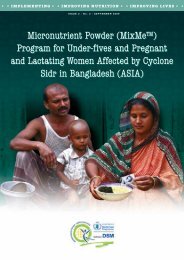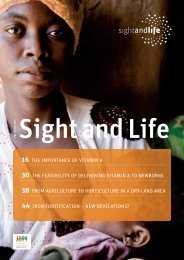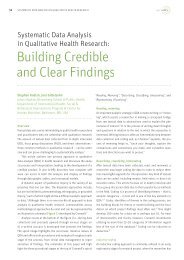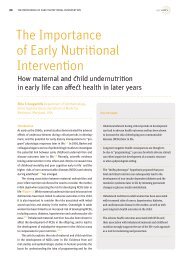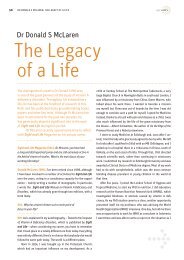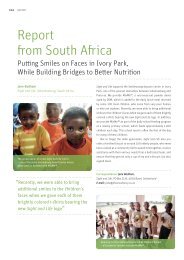16 intrauterine programming of ncd 24 olson memori... - DSM
16 intrauterine programming of ncd 24 olson memori... - DSM
16 intrauterine programming of ncd 24 olson memori... - DSM
- No tags were found...
Create successful ePaper yourself
Turn your PDF publications into a flip-book with our unique Google optimized e-Paper software.
SIGHT AND LIFE | VOL. 25 (2) | 2011 THE LINK BETWEEN NUTRITION, DISEASE AND PROSPERITY 3535creases the risk <strong>of</strong> cardiovascular complications, thus havinga direct impact on NCDs. In addition, health more broadly, includingNCD prevention, contributes to poverty reduction andso anti-NCD strategies could also be part <strong>of</strong> Goal 1 (Eradicateextreme poverty and hunger). The MDGs have to address the notion<strong>of</strong> human development having quality <strong>of</strong> life, not only theextension <strong>of</strong> life, as a central value.A recent Lancet paper on NCDs highlights that there are tworeasons why the poorest are the most likely to develop and dieprematurely from NCDs. First, they have less access to comprehensivehealth services and secondly, they live in environmentswhere policies to tackle NCDs are either non-existent or inadequate.Furthermore, they are more likely to be exposed to risksincluding a poor nutritional status. Thus it cannot be neglectedthat NCDs can also be causal in poverty. (Figure 2)Addressing NCDs among women and childrenGovernments and development and donor agencies need to beproactive with regard to NCDs. The approach needs complex,multifaceted, and intersectoral interventions based on long timeperiods to tackle the wide range <strong>of</strong> social determinants <strong>of</strong> health;a decisive move in this direction is a prerequisite for the reduction<strong>of</strong> poverty and health inequities.The conditions in which women and children are born, growup, live and work have a major impact on their health. Thusthe Global Strategy for Women’s and Children’s Health states:“Efforts to improve health must be closely linked to those intendedto tackle poverty and malnutrition, improve access to education,ensure gender equity and empowerment, tackle major diseases,and improve access to safe drinking water, adequate sanitationand a clean, safe environment. Integrating the care <strong>of</strong> womenand children with other services is an efficient and cost-effectiveroute to success.” The reality is that, despite the billions <strong>of</strong> dollarsgiven and spent on aid and development each year, we simplydo not allocate enough resources to solve all <strong>of</strong> the world’sbiggest problems. It thus becomes necessary to direct additionalresources where they can achieve the most good.Nutrition’s role in human health and developmentOver and above food security (sufficient food to provide the requiredenergy), nutrition security (the nutritional quality <strong>of</strong> thefood and care) is thus not only the cornerstone to preventing undernutritionbut also contributes to reducing and, in many cases,preventing NCDs. Nutrition has to be the basis <strong>of</strong> judging nationaldevelopment. Without good nutrition, neither nutritionaldeficiencies nor NCDs can be controlled. The 2008 CopenhagenConsensus saw the world’s most distinguished economists compareways to spend US$75 billion on more than 30 interventionsaimed at addressing the world’s top 10 biggest challenges. Theirbasis was costs versus benefits, analyzing interventions that withrelatively small amounts <strong>of</strong> money could generate significant returnsin terms <strong>of</strong> health, prosperity, and community advantages.Among these interventions, five in the top 10 featured nutritionprograms, supplementation and fortification with micronutrients.figure 2: Inter-relation between poverty, chronic disease, and developmentKey risk factors influencing the onsetand course <strong>of</strong> chronic diseases> Tobacco use and exposure> Poor nutrition> Physical inactivity> Alcohol misuse> Indoor air pollution> Decreased access to health care servicesPovertyand socialdeterminants<strong>of</strong> healthChronicdiseasesChronic diseases and their riskfactors limit the abilityto reach development goalsMillennium Development Goals> Poverty reduction (MDG 1)> Reduce child mortality (MDG 4)> Improve maternal health (MDG 5)> Combat HIV/AIDS, malaria, andtuberculosis (MDG 6)Effect <strong>of</strong> chronic diseases and their riskfactors on individuals and families> Low productivity> Increased risk <strong>of</strong> disabilities> High household expenditures,which include health care> Increased risk <strong>of</strong> premature death



